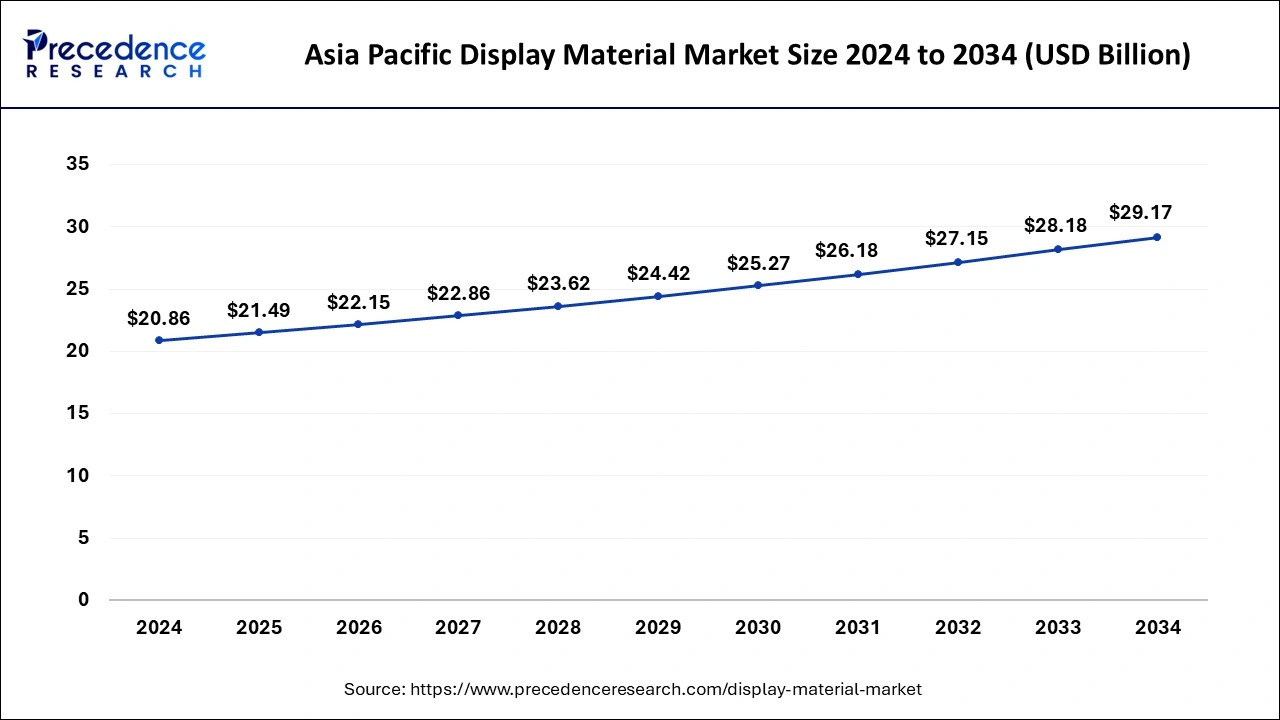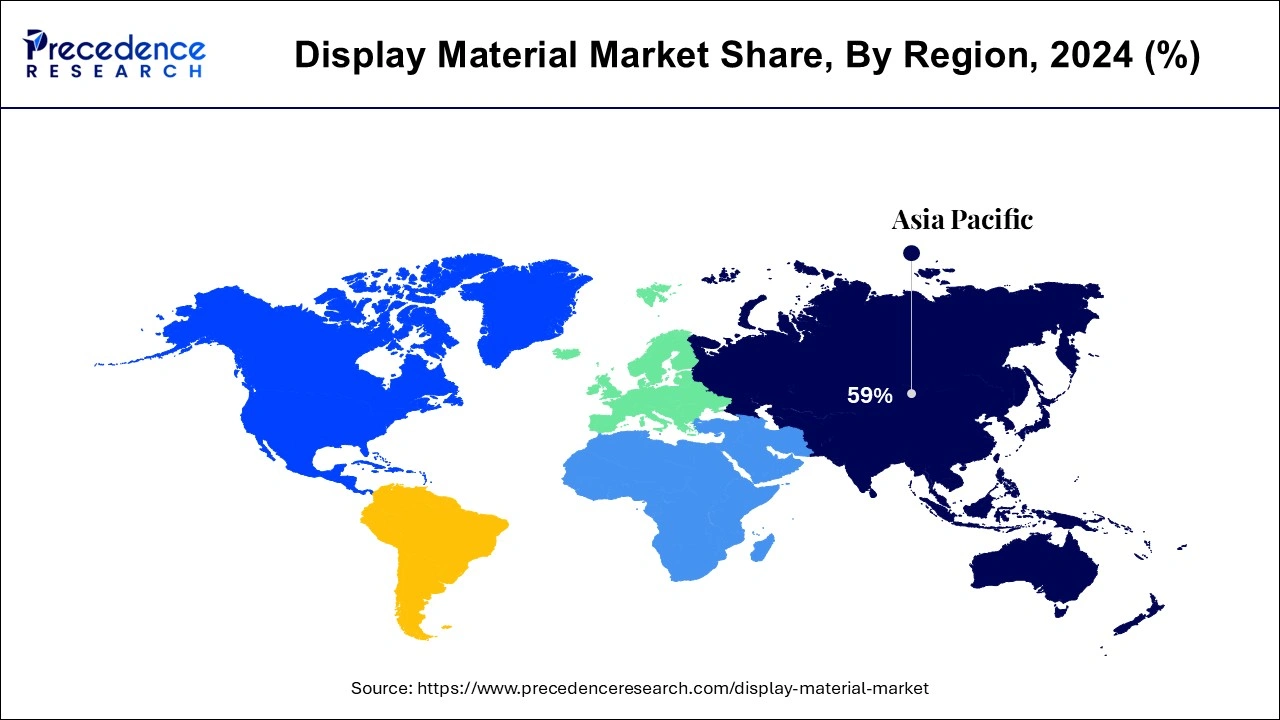September 2024
The global display material market size is accounted at USD 36.83 billion in 2025 and is forecasted to hit around USD 49.16 billion by 2034, representing a CAGR of 3.21% from 2025 to 2034. The Asia Pacific market size was estimated at USD 20.86 billion in 2024 and is expanding at a CAGR of 3.41% during the forecast period. The market sizing and forecasts are revenue-based (USD Million/Billion), with 2024 as the base year.
The global display material market size was calculated at USD 35.83 billion in 2024 and is predicted to reach around USD 49.16 billion by 2034, expanding at a CAGR of 3.21% from 2025 to 2034. The global display material market is expanding rapidly due to the increasing demand for LCDs from various end-use sectors, rising demand for environmentally friendly and energy-efficient display materials, and the growing use of OLED technology in televisions and smartphones.

The Asia Pacific display material market size was evaluated at USD 20.86 billion in 2024 and is projected to be worth around USD 29.17 billion by 2034, growing at a CAGR of 3.41% from 2025 to 2034.

The global market for display material is divided into North America, Asia Pacific, Europe, Latin America, the Middle East, and Africa based on geographic analysis. Due to the substantial market share held by the Asia Pacific region, the media and entertainment industries' rapid growth and expansion, as well as the region's abundant supply of raw materials, all of which are contributing factors to the worldwide display material market's rapid expansion.

Display material is an aspect which is mainly used on display cell phones, digital cameras, media players, and televisions. Among the crucial display components are film, glass, backlights, ICs, and some organic materials that are flexible and used to manufacture displays. Different technologies, such as OLED, LCD, IPS, AMOLED, and others, are used to create displays.
The advancement of electronic display technology is made possible by several materials and methods. Plastics are ideal for point-of-purchase displays because they are inexpensive, have excellent aesthetic qualities, and are simple to manufacture.
Plastic is sturdy and lightweight, and wide varieties may be easily customized with painting and printing. When using showcases made of plastics like acrylic, high-impact polystyrene, polycarbonate, and expanded PVC, customers have a rich shopping experience. These materials are available in various colors and textures and can be made with basic woodworking tools.
Many plastic sheet materials can be produced on strip heaters and thermoformed, and they can be swiftly glued together using solvent cement blocks and adhesives. Polycarbonate, special acrylic, and PETG materials designed to transmit and diffuse LED light can create stunning backlit displays.
As long as there is a need for high-end consumer electronics, specifically TV applications, and as long as the umbrella ecosystem is accepted, the market for display materials will keep growing. The growing size and resolution of TV displays are driving the growth of the display material market. Therefore, it is likely that the growing adoption of OLED display technology and its expanding applications will fuel rising demand for the market of display material in the years to come.
In OLED technology, a light-emitting diode's light-emitting layer is an organic substance, and organic molecules typically release light in reaction to an electric current. The extraordinary rapid expansion of quantum dot OLED and LCD will also likely increase demand for display materials in the future.
Throughout the projection, it is also expected to positively affect the display materials market. Despite several motivating elements, the display material market will likely decrease and have a variable growth rate because of the IP protection and exclusivity of advanced and emerging display materials.
The high power consumption of IPS displays, which leads to crisper screens and faster battery drain, is hurting the display material market. The high manufacturing costs and higher engineering complexity that make it difficult to be installed in consumer devices like entry-level tablets and budget smartphones are two major factors restraining the global market for display material.
The display material market will grow over the next years due to the continued demand from OLED display panel manufacturers for thin substrate sheets of exceptionally high quality.
| Report Coverage | Details |
| Global Market Size in 2025 | USD 36.83 Billion |
| Global Market Size by 2034 | USD 49.16 Billion |
| Growth Rate from 2025 to 2034 | CAGR of 3.21% |
| Largest Market | Asia Pacific |
| Base Year | 2024 |
| Forecast Period | 2025 to 2034 |
| Segments Covered | Technology, Component, and Application |
| Regions Covered | North America, Europe, Asia-Pacific, Latin America, and Middle East & Africa |
The increasing demand for LCDs from various end-use sectors, including automotive, consumer electronics, and healthcare, is expected to drive robust growth in the global market for display material during the forecast period. The growing use of OLED technology in televisions and smartphones is also anticipated to fuel industry expansion. Additionally, over the upcoming years, it is projected that the rising demand for environmentally friendly and energy-efficient display materials will open up new prospects for market participants.
The growing popularity of smartphones and tablets, Advances in display technology, such as the development of flexible and foldable displays, The increasing popularity of smart TVs, which use internet-connected display panels, The increasing adoption of advanced driver assistance systems (ADAS) and infotainment systems in vehicles.
The rise in popularity of gaming, the increasing use of virtual and augmented reality technology, the adoption of IoT devices, like smart home devices and wearables, and the increase in e-commerce and online learning due to the COVID-19 pandemic is driving demand for display materials.
The market is divided into OLED and LCD segments based on technology. Due to the growing use of OLED screens in smart wearables and smartphones, the LCD category commands a sizable portion of the market. Making an LCD panel requires more layers, materials, or components.
A colour filter layer, liquid crystal, and a backlight unit are also used in LCDs, which are not necessary for OLED displays, thereby accelerating the growth of the Market for Display Materials. Two layers of polarizers and substrates are used in LCDs instead of just one layer of each plate in OLED.
The market is divided into polarizers, substrates, colour filter layers, liquid crystals, backlighting units, and others based on the component. Due to industry leaders' rising investments in enhancing these materials for greater energy efficiency and extended lifespan, the Polarizer category maintains a sizable market share. These reasons are driving the display material market growth.
By Application, the market is divided into television, smartphones and tablets, signage and large-format displays, and smart wearables. Due to the rising display materials consumption used in LCD panels for TVs, the television industry owns a sizable portion of the market.
The majority of the display material demand comes from smartphones and tablets. Shipments of OLED panels for TV applications are increasing exponentially, driven by LG, which is accelerating the expansion of the market for display material.
By Technology
By Component
By Application
By Geography
For inquiries regarding discounts, bulk purchases, or customization requests, please contact us at sales@precedenceresearch.com
No cookie-cutter, only authentic analysis – take the 1st step to become a Precedence Research client
September 2024
October 2023
December 2024
August 2024